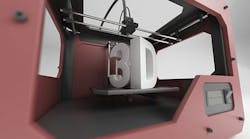When the concept of additive manufacturing (AM) first entered the public sphere nearly 40 years ago, its applications were mainly focused on fabricating small, complex items with plastic polymers. In the decades since, our understanding of additive manufacturing’s potential benefits has exploded while costs have dropped, leading to breakthroughs like fabricated organs and prosthetics and the proliferation of 3D printers in K-12 classrooms around the world.
Today, additive manufacturing has the potential to unlock new sophisticated design and production capabilities for industrial companies, allowing manufacturers to produce customized goods and deliver parts faster. However, the powerful machines needed to additively manufacture mission-critical parts with advanced materials are much more complex than a classroom model, especially on an industrial scale.
According to the 2019 Wohler’s Report, additive manufacturing represents just 0.077% of all global manufacturing. Though the promise of additive manufacturing is leading more companies to experiment with the technology, three key industry challenges must be solved before we see widespread mainstream adoption of additive manufacturing approaches: certification of additive parts, the design toolchain, and training for engineers.*
Challenge #1: Certification
In order for an additively-manufactured (AM) safety-critical part to move from conceptual design into commercial or military aerospace use, regulators must first approve it. While conventionally manufactured parts have the advantage of decades of knowledge in manufacturing processes, various types of potential defects and field experience, the certification process for AM parts needs to be more rigorous because it is still an emerging technology. In AM, the material properties are strongly dependent on local thermal history to the extent that the material microstructure (grain size and shape) could be different in the XY plane and in build direction (Z). Moreover, material properties could vary from one location in a part to another based on the design features.
In many ways, the burden is on the manufacturing companies to demonstrate to certification authorities like the Federal Aviation Administration (FAA), European Union Aviation Safety Agency (EASA), and Department of Defense (DoD) that additively manufactured parts meet the design intent. We must also demonstrate a thorough understanding of the key process variables and their impact on material properties and design limits.
The best way for the industry to tackle this challenge is to develop a physics-based understanding of the process, identify key process variables, develop in-process monitoring methods and validate the methodology on aerospace components of varying complexity.
Challenge #2: Design Toolchain
Part of the promise of additive manufacturing is that it will open up a new era of design freedom for engineers. Additive manufacturing allows engineers to use novel organic shapes in their designs, which may be lighter and have better performance than conventionally designed parts.
However, to leverage this design freedom, we need the right tools and methods for engineers to change the way they think about design concepts and integrate these new methods into existing workflows. While complexity comes for free with additive, there are limitations in the type of features and part sizes that can be built. In the last few years, a number of tools have emerged that allow topology optimization of parts to increase stiffness and reduce weight—however, very few, if any, include the AM process or build constraints. In addition, most AM parts require post-build machining operations, and incorporating those requirements during the conceptual design can minimize the design iterations.
The answer is to develop an end-to-end tool chain that covers the entire AM value stream: from part design, build orientation and process-specific constraints, to considerations for powder removal and post-build manufacturing operations such as milling.
Challenge #3: Training for Engineers
Additive manufacturing is still maturing, and it’s creating unique HR challenges as companies look to bring in fresh talent and retrain their existing engineering workforce.
While younger engineers entering the field may have used 3D printing tools in a school setting, more experienced engineers who are accustomed to working within conventional manufacturing constraints will need additional training to open them up to the possibilities of additive manufacturing. This challenge is amplified if 20,000-30,000 engineers need retraining, and companies will need to find ways to integrate this education with standard, day-to-day work.
The industry recognizes this issue broadly, and there are a number of third parties offering AM training courses and certificate programs for working engineers. In academia, universities like MIT, Penn State, and Purdue University are thinking about this challenge and offering additive certification programs, but it’s still early days. While you can’t get a 4-year engineering degree in AM right now, I expect we’ll see minors and interdisciplinary B.S. programs in AM in the earlier half of the next decade.
At United Technologies Corp., we’re tackling this challenge by introducing a new internal training program called the Additive Experience, or AddEx, which offers our engineers the opportunity to participate in practical hands-on demonstrations and lectures on additive manufacturing during a two day-long program.
We’ve found that with this particular technology, hands-on experiences like AddEx are the best way to drive a culture of understanding and change within UTC’s Engineering and Operations functions. This program is helping us move beyond current limited design approaches to the full possibilities of additive manufacturing—envisioning parts that cannot be built in a conventional manner.
How We’ll Get There: Collaboration
While these three challenges may seem daunting, I believe the future of additive manufacturing innovation is bright. If we are going to unlock its promise at scale, we’ll need to work together as an industry to share our lessons learned and develop best practices.
Venkat Vedula is executive director, Additive Manufacturing Center of Expertise, at United Technologies Corp.
*Statistic has been changed from the original to better reflect manufacturing numbers, rather than other industries as well.




